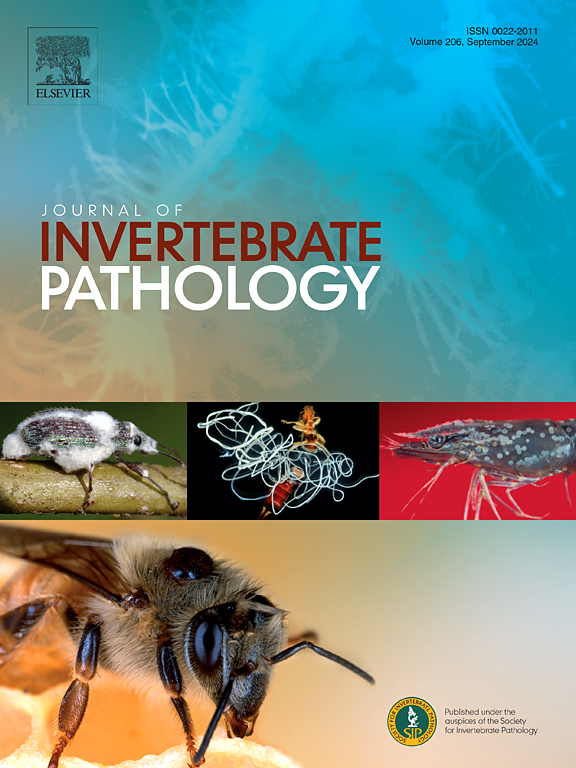A century of advancement in entomopathogenic nematode formulation and application technology
IF 2.4
3区 生物学
Q1 ZOOLOGY
引用次数: 0
Abstract
Entomopathogenic nematodes (EPNs) in the genera Heterorhabditis and Steinernema are biocontrol agents used to control a diverse array of economically important insect pests. Generally, nematodes are applied in aqueous suspensions using standard agricultural equipment (e.g., sprayers and irrigation systems). Formulation and application parameters are critical to the level of biocontrol efficacy achieved by EPNs. Moreover, biocontrol efficacy is mitigated by various abiotic and biotic factors. For example, abiotic factors such as ultraviolet (UV) radiation, desiccation, or temperature extremes can severely limit EPN efficacy in biocontrol. Additionally, biotic aspects, including matching the appropriate EPN species to the target pest, and a suitable application rate, are of extreme importance. EPN formulations can facilitate storage and ease-of-handling during application. Improved formulations may also protect the EPNs from harmful environmental conditions and enhance efficacy and persistence. For example, protective gels or nanoparticle formulations can protect nematodes from UV and desiccation and thereby expand EPN use to aboveground applications. Novel application approaches can also enhance EPN efficacy such as using pheromone boosters to increase nematode movement and infectivity. In this review, we summarize the current status of EPN formulation and application technology and provide examples of novel developments that will help propel EPNs toward future success. Following a brief introduction on current formulation and application practices, we provide information on the basic abiotic and biotic factors that affect efficacy, followed by approaches to improve efficacy within the framework of formulation and application technology.

昆虫病原线虫制剂和应用技术的一个世纪进展。
昆虫病原线虫属(Heterorhabditis and Steinernema)是一种生物防治剂,用于防治多种具有重要经济意义的害虫。一般来说,线虫是用标准的农业设备(例如喷雾器和灌溉系统)在水悬浮液中施用的。配方和应用参数对EPNs的生物防治效果至关重要。此外,生物防治效果会受到各种非生物和生物因素的影响。例如,紫外线(UV)辐射、干燥或极端温度等非生物因素可能严重限制EPN在生物防治中的功效。此外,生物方面,包括将适当的EPN物种与目标害虫相匹配,以及适当的施用量,都是极其重要的。EPN配方可以在应用过程中方便存储和易于处理。改进的配方还可以保护epn免受有害环境条件的影响,提高功效和持久性。例如,保护凝胶或纳米颗粒配方可以保护线虫免受紫外线和干燥,从而将EPN的使用扩展到地面应用。新的应用方法也可以提高EPN的功效,如使用信息素增强剂来增加线虫的运动和传染性。在本文中,我们总结了EPN配方和应用技术的现状,并提供了有助于推动EPN走向未来成功的新发展的例子。在简要介绍目前制剂和应用实践的基础上,介绍影响疗效的基本非生物因素和生物因素,以及在制剂和应用技术框架内提高疗效的途径。
本文章由计算机程序翻译,如有差异,请以英文原文为准。
求助全文
约1分钟内获得全文
求助全文
来源期刊
CiteScore
6.10
自引率
5.90%
发文量
94
审稿时长
1 months
期刊介绍:
The Journal of Invertebrate Pathology presents original research articles and notes on the induction and pathogenesis of diseases of invertebrates, including the suppression of diseases in beneficial species, and the use of diseases in controlling undesirable species. In addition, the journal publishes the results of physiological, morphological, genetic, immunological and ecological studies as related to the etiologic agents of diseases of invertebrates.
The Journal of Invertebrate Pathology is the adopted journal of the Society for Invertebrate Pathology, and is available to SIP members at a special reduced price.

 求助内容:
求助内容: 应助结果提醒方式:
应助结果提醒方式:


